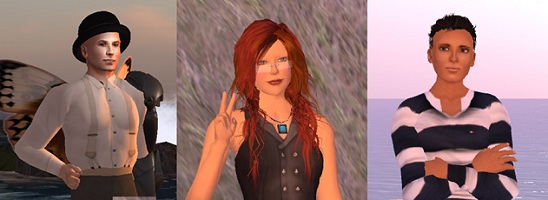T25: A journey into the world of avatar creation and use
Half Day Tutorial
Jacquelyn Morie (short bio)
Institute for Creative Technologies, University of Southern California, USA
Kip Haynes (short bio)
Institute for Creative Technologies, University of Southern California, USA
Eric Chance (short bio)
Institute for Creative Technologies, University of Southern California, USA
Objectives:
- Understand how to create and use avatars in a variety of immersive environments
- Gain knowledge about the scope of avatar use: history, demographics, statistics, styles and more
- Explore the most recent (and future) research into avatar use and how it affects the user
Content and Benefits:
This tutorial will cover the rise of avatar use within immersive environments and how this represents a sea change for interfacing with one’s computer. The tutorial will cover the history of avatar use, how and why people use avatars, and the huge rise in the numbers of people who now regularly use some type of avatar representation. We will cover avatar creation systems and then present an in-depth look at the latest research concerning avatar use. The session will close with a group discussion of suggested future research directions in this area.
Target Audience:
People who are interested in, create, or use immersive environments that feature avatars. Social experts who wonder about the impact of the increasing use of avatars, especially by children. Researchers interested in the psychological aspects of avatar use. Virtual world developers who seek insights to making more accessible and interesting environments.
Bio Sketch of Presenters:

- Jacquelyn Ford Morie, PhD, is a Senior Researcher at USC’s Institute for Creative Technologies (ICT), working in immersive environments for training and health applications. She has created several novel telehealth care activities in virtual worlds and brings her background in art and computer animation to enhance patient engagement with these programs. Previously she spent six years in the animation and special effects industries. Her early research was in developing emotionally evocative virtual reality immersive environments, and currently she is also begun a program of research into how avatars affect the people who use them.
- Kip Haynes, who earned his degree in Computer Engineering from WVU in 1998, spent the early part of his career developing high performance parallel distributed rendering applications for large scale data visualization projects. He joined the ICT, in 2003 as manager of a research project investigating parallel and distributed systems for a variety of ARMY training and simulation efforts. Subsequently he has overseen the technical integration and implementation of several of the ICT's high profile military training systems, including Joint Effects Call for Fire Training (JFETS), INOTS (Immersive Naval Officer Training Simulation), ELITE (Emergent Leader Immersive Training Environment) and TOPSS-VW (Transitional Online Post-deployment Soldier Support in Virtual Worlds).
- Eric Chance is a USC film program alumnus who specializes in user-generated content for the virtual worlds such as Second Life, where he has been a resident since early 2004. Past clients in SL include Linden Lab, blueair.tv, Eyebeam, and ICT. He has worked in the film and live audio industries, theatrical set construction, and studied comic book design from 1997-1998 under the editor-in-chief of Antarctic Press. He is passionate about interactivity, sound, game design, art, and learning. Programs and languages he is familiar with include Second Life, Qavimator, Photoshop, Maya, Cool Edit Pro/Adobe Audition, Premiere, Avid, Speed Razor, LSL, C++, and Max/MSP among others.


